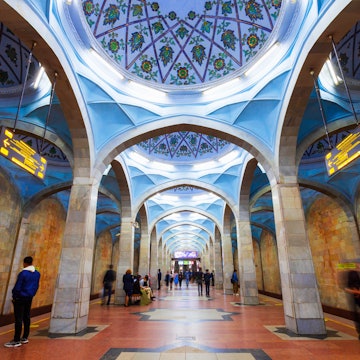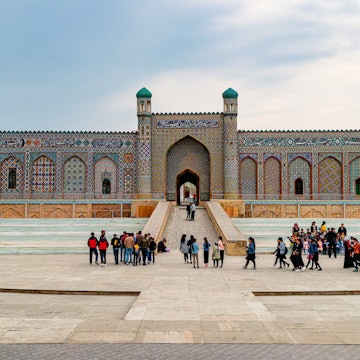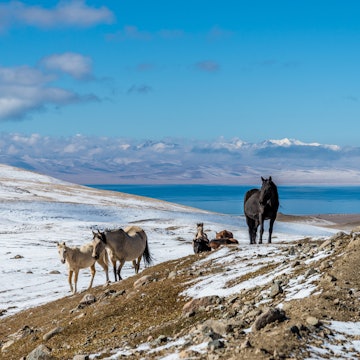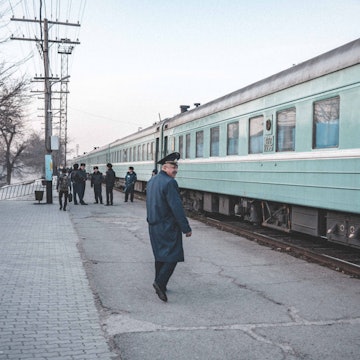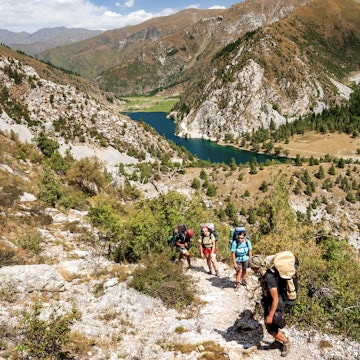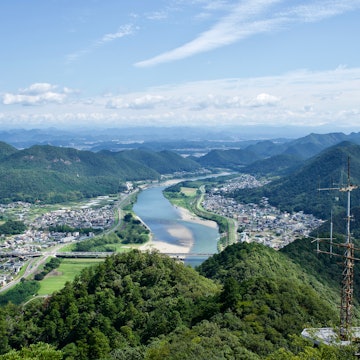

A traditional hunter with his eagle, Kyrgyzstan. Sahan Nuhoglu/Shutterstock
It doesn’t border Afghanistan. It isn’t part of Russia (or in Russia’s “backyard”). And it definitely is not in Iraq (that’s Kurdistan).
These are all questions I’ve gotten numerous times from well-meaning but poorly informed friends, family members and strangers in the nearly 13 years I’ve been based in Kyrgyzstan. While the country and region are slowly gaining popularity among international travelers, there are still plenty of misconceptions about this alluring Central Asian place.
From planning a trip to arriving in the country and social mores to be aware of while you’re traveling around, these are the things I wish I’d known the first time I traveled to Kyrgyzstan.

1. Kyrgyzstan is not just a summer or adventure destination
Popular perception holds that tourism in Kyrgyzstan is all about horse trekking and hiking through big mountains. And while these activities do indeed draw most visitors, they are certainly not the only things to do here. Adventure travelers can expect plenty of hiking, with pastures full of wildflowers in the spring and changing autumnal leaves in the fall. Winter opens the opportunity for skiing, cross-country, ice skating and snowshoe tours.
Kyrgyzstan has fantastic opportunities for culture, too. You can explore the creation of felt handicrafts and shyrdak carpets through studio visits and hands-on classes; enjoy displays of traditional salbuurun hunting with trained eagles and hounds; and set out on culinary tours and cooking classes. Even a simple yurtstay will offer insights into Kyrgyzstan’s culture, appealing to those who aren’t adrenaline junkies or hardcore hikers.
2. You may not need a visa…
Citizens of 60 countries can travel to Kyrgyzstan without visas for periods of 30 days or more. This includes those with passports from European and North American countries, who are allowed to stay for up to 60 days within a 120-day period. Those who do need visas can typically get them on the government’s straightforward e-visa website.
3. …though you might need a border permit
Regardless of nationality (including Kyrgyz citizens), travelers require a “border permit” document to travel near the borders with Tajikistan and China, plus a small stretch of the border with Kazakhstan. While it is possible to arrange this independently, it can take several weeks and involve several bureaucratic steps – which means visitors would do better to contact a tour operator in advance and pay US$30–50 to have the permit arranged on their behalf.
Another nuance: the border permit is only required for visitors who stay in a border region; it’s not required for visitors who simply enter or leave Kyrgyzstan via an overland border checkpoint.

4. You should expect snow in any season
Since many tourists do come for the high mountains and big hikes, this type of traveler should pack for every condition. Son-Köl lake is a famous place that can experience the weather conditions of all four seasons in a single day, and anywhere in the Tien Shan can see sub-zero temperatures and unexpected snowstorms, even in the middle of summer.
5. Know your ground-transfer options before touching down at Manas International Airport
Walking out of the baggage claim at Manas Airport in Bishkek, you can expect a loud scrum of taxi drivers all clamoring for your business. (Some tourists have even reported having their bags taken from their hands, forcing them to follow.) If you plan to take a taxi, avoid this hassle, as well as the complicated queue of Yandex drivers, by looking for the taxi desk just before baggage claim. With fares to various points within the city hovering just above 1000som, it’s a touch more expensive than the alternatives – but avoiding the hassle is well worth it.
Alternatively, there are two options for public transport into the city center. Minibus 380 runs every half hour from around 7am to 9pm to the central intersection of Chuy and Moladaya Gvardia for 50som; the driver will often charge the same price for your luggage. The GoBus shuttle (hourly; 200som) costs more but travels farther in the city along Chuy and Sovietskaya/Abdrakmanov, terminating at the Tommi Mall shopping center in the south.
6. Pick up a SIM card for some of the cheapest mobile data in the world
Stay connected across the country by picking up a local SIM card, either at the airport or in any town or city. Kyrgyzstan’s mobile data is among the cheapest in the world, with 1GB costing as low as $0.05. Major local carriers offer free SIM cards to arriving passengers at Bishkek airport: Beeline is reliable in cities but often drops network in rural areas, while O! and MegaCom have stronger coverage in rural regions. If you’ll be staying in a specific area for a length of time, ask local contacts there which is the best choice.

7. If you stay more 30 days, you’ll have to register your IMEI
If you’ll be using your mobile phone in Kyrgyzstan for more than 30 days, it will stop working unless you register the IMEI (your device’s unique identifier) with a government database. The process is inexpensive (around 550som) but cumbersome via the IMEI.kg website – and does raise privacy concerns that many visitors will find off-putting.
8. Count on Yandex to get around major cities
One of the benefits of a working SIM card is the ability to use Yandex Go, the Russian rideshare app present in post-Soviet countries. Many international credit cards will have authorization problems within the app, but it’s also possible to pay by cash – just don’t expect drivers these days to be carrying around change.
9. For cash, the dollar is king
While credit card payments and ATMs are common in cities, cash rules in towns and rural areas. If you’re changing currency, it is possible to change euros and pounds, with a markup – but in most places you’ll get closer to official exchange rates with US dollars than any other currency. Regardless of what you’re carrying, bring fresh, clean notes without tears or folds. If you’re carrying $100 bills, make sure they’re the new ones, in circulation since 2013.
10. When queueing, learn to ask, “Who’s last?”
Whether you’re heading to passport control or fighting to get into the stadium for a match of kok boru (a regional horse sport where teams face off for control of a goat carcass), orderly queuing is not a universal practice in Kyrgyzstan. Should you find yourself in a place with lots of folks milling about but no line (a government office, say), ask loudly: “Kto posledniy?” Whoever answers you is last in the “queue.” Be sure to listen for and stay ready to respond to the next person who poses the question.
11. Be prepared to shake a lot of hands
Central Asian men shake hands. A lot. When entering or leaving a room or gathering, expect to shake hands with every other male guest – even if you’ve barely interacted with them, or haven’t at all. Central Asian women don’t typically shake hands, save for in some (but not all) business environments. To be safe, men should allow local women to offer a hand – or not. Foreign women fall somewhere in between: a handshake is not expected but usually accepted – with the exception of greeting religious men, who may refuse to shake hands with an unfamiliar woman.

12. Go easy on the tablecloth spread
By tradition and as a sign of hospitality, a Kyrgyz tablecloth (dastorkon) should be piled with food. Even if you’ve just popped into a guesthouse or yurtstay there will almost always be a table full of sweets, fruit, nuts and other fare. Feel free to help yourself but within reason. Local hosts have occasionally reported over the years that some tourists feel entitled to take everything on the table, sometimes even dumping it in their bags to take for their onward travels.
13. Bread is sacred
Bread will be served, or at least offered, at nearly every meal you eat in a public space in Kyrgyzstan. Feel free to eat or skip it – but always treat bread with respect. Never place it upside down on the table, always tear it with two hands (never breaking it with just one) and never, ever throw bread away. Just leave it be, and it will be collected for dogs or livestock.

14. Expect to encounter horsemeat and horse milk
The horse is central to Kyrgyz culture – a principle that extends to cuisine as well. Beshbarmak (noodles with broth) is often made with horsemeat (particularly at weddings or funerals) – and in recent years it’s become possible to find steak, shashlyk and other dishes prepared using horsemeat, too. Also wildly popular is kymyz, horse milk fermented in sheepskin sacks – most delicious when savored in a mountain yurt camp just a few steps from the source. (While connoisseurs claim to be able tell the origin of the milk from the terroir of the grass on which the horse grazed, we remain skeptical.)
Locals sometimes spend five days or more at special health retreats during which guests drink fresh horse milk at regular intervals throughout the day to cleanse the body and boost the immune system. The uninitiated, however, would be best advised to steer clear – unless they possess an iron stomach, or at least easy access to a private bathroom.
15. Kyrgyzstan is safe for visitors…
The vast majority of international visitors experience no problems with their personal safety in Kyrgyzstan; even the once widely discussed false-police scams targeting foreigners at Bishkek’s Osh Bazaar have long been curtailed. Nonetheless, visitors of South Asian backgrounds would do well to read up on the ethnic riots of May 2024, and to keep alert when moving around the capital, especially at night.
16. …but road and trail safety can be an issue
The greatest risks most visitors to Kyrgyzstan face come when they’re on the move, whether that’s hiking or horseback riding or driving on the highways. Outdoor activities pose physical risks wherever in the world you do them – though in remote Kyrgyzstan you’re often a very long way from the nearest hospital.
But the greatest risk to most visitors is merely riding on the roads. Active enforcement and radar cameras have improved road safety considerably in the last decade, but you can still anticipate a lackadaisical attitude among drivers on Kyrgyzstan’s highways. Blind passing on short straights and even corners is still fairly common, and there’s always a real chance of livestock walking slowly across the highway just around the next curve.

17. You can camp just about anywhere – but it’s polite to ask first
Wild camping is common for visitors more or less anywhere in the country; many cyclists even camp right on the edge of villages. If you see buildings nearby or someone who’s obviously working the land, it’s both logical and respectful to go shake hands and formally request to pitch your tent. Otherwise, you’re almost always in the clear.







